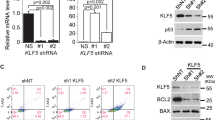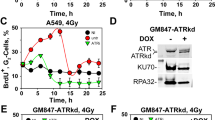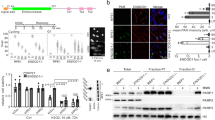Abstract
The PTEN tumour suppressor1 and pro-apoptotic2 gene is frequently mutated in human cancers. We show that PTEN transcription is upregulated by Egr-1 after irradiation in wild-type, but not egr-1−/−, mice in vivo. We found that Egr-1 specifically binds to the PTEN 5′ untranslated region, which contains a functional GCGGCGGCG Egr-1-binding site. Inducing Egr-1 by exposing cells to ultraviolet light upregulates expression of PTEN messenger RNA and protein, and leads to apoptosis. egr-1−/− cells, which cannot upregulate PTEN expression after irradiation, are resistant to ultraviolet-light-induced apoptosis. Therefore, Egr-1 can directly regulate PTEN, triggering the initial step in this apoptotic pathway. Loss of Egr-1 expression, which often occurs in human cancers, could deregulate the PTEN gene and contribute to the radiation resistance of some cancer cells.
This is a preview of subscription content, access via your institution
Access options
Subscribe to this journal
Receive 12 print issues and online access
$209.00 per year
only $17.42 per issue
Buy this article
- Purchase on Springer Link
- Instant access to full article PDF
Prices may be subject to local taxes which are calculated during checkout




Similar content being viewed by others
Accession codes
References
Simpson, L. & Parsons, R. Exp. Cell Res. 264, 29–41 (2001).
Lu, Y. et al. Oncogene 18, 7034–7045 (1999).
Steck, P. A. et al. Nature Genet. 15, 356–362 (1997).
Li, J. et al. Science 275, 1943–1947 (1997).
Liaw, D. et al. Nature Genet. 16, 64–67 (1997).
Arch, E. M. et al. Am. J. Med. Genet. 71, 489–493 (1997).
Marsh, D. J. et al. Nature Genet. 16, 333–334 (1997).
Myers, M. P. et al. Proc. Natl Acad. Sci. USA 95, 13513–13518 (1998).
Suzuki, A. et al. Curr. Biol. 8, 1169–1178 (1998).
Wang, X. et al. J. Immunol. 164, 1934–1939 (2000).
Weng, L. P., Brown, J. L. & Eng, C. Hum. Mol. Genet. 10, 237–242 (2001).
Weng, L. P. et al. Cancer Res. 59, 5808–5814 (1999).
Ge, N. L. & Rudikoff, S. Oncogene 19, 4091–4095 (2000).
Sukhatme, V. P. et al. Cell 53, 37–43 (1988).
Huang, R.-P., Darland, T., Okamura, D., Mercola, D. & Adamson, E. D. Oncogene 9, 1367–1377 (1994).
Huang, R.-P., Liu, C.-T., Fan, Y., Mercola, D. A. & Adamson, E. D. Cancer Res. 55, 5054–5062 (1995).
Huang, R. P. et al. Int. J. Cancer 72, 102–109 (1997).
Liu, C. et al. J. Biol. Chem. 274, 4400–4411 (1999).
de Belle, I. et al. Oncogene 18, 3633–3642 (1999).
Ahmed, M. M. et al. J. Biol. Chem. 272, 33056–33061 (1997).
Ahmed, M. M. et al. J. Biol. Chem. 271, 29231–29237 (1996).
Huang, R.-P., Wu, J.-X., Fan, Y. & Adamson, E. D. J. Cell Biol. 133, 211–220 (1996).
de Belle, I., Mercola, D. & Adamson, E. D. Biotechniques 29, 162–169 (2000).
Stambolic, V. et al. Cell 95, 29–39 (1998).
Huang, R. P. & Adamson, E. D. Oncogene 10, 467–475 (1995).
Lee, S. L. et al. Science 273, 1219–1221 (1996).
Todaro, G. J. & Green, H. J. Cell Biol. 17, 299–313 (1963).
Acknowledgements
We are indebted to A. Krones for her skilled assistance in providing mutant and wild-type mouse tissues. We thank E. Ruoslahti and J. Reed for comments on the manuscript. We are indebted to J. Milbrandt, Washington University Medical School, St Louis, for the gift of Egr-1 knockout animals. This work was supported by grants from the National Institutes of Health (E.D.A., D.M. and T.M.); from the Department of Defense (E.D.A. and I. de B.) and from the Tobacco Related Diseases Research Program of the University of California (I. de B.).
Author information
Authors and Affiliations
Corresponding author
Rights and permissions
About this article
Cite this article
Virolle, T., Adamson, E., Baron, V. et al. The Egr-1 transcription factor directly activates PTEN during irradiation-induced signalling. Nat Cell Biol 3, 1124–1128 (2001). https://doi.org/10.1038/ncb1201-1124
Received:
Revised:
Accepted:
Published:
Issue Date:
DOI: https://doi.org/10.1038/ncb1201-1124



